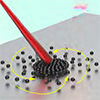| Nov 23, 2023 |
|
|
|
(Nanowerk News) For decades, researchers have sought to emulate the collective behavior of natural systems like schools of fish or flocks of birds using synthetic microscale robots. Such robot collectives could enable a variety of applications, from targeted drug delivery to environmental remediation. However, realizing robust 3D motion of these synthetic swarms without dispersion has proven an enduring challenge.
|
|
Reporting their findings in Science Advances (“Bioinspired self-assembled colloidal collectives drifting in three dimensions underwater”), researchers from the Chinese University of Hong Kong and the Max Planck Institute for Intelligent Systems have developed a bimodal actuation strategy that combines magnetic and optical fields to achieve controlled 3D locomotion of colloidal robot collectives.
|
|
As the authors explain, most existing colloidal microrobots rely on physical boundaries to move around. For example, colloidal particles activated by ultrasound waves use the walls of their container to “walk” along surfaces. This strong dependence limits maneuverability, as the microbots cannot detach from substrates or overcome barriers larger than their own size. Some 3D control has been demonstrated with magnetically-driven helical microswimmers, but these systems struggle to maintain cohesion during 3D motion.
|
 |
| Three-dimensional drifting control of magnetic colloidal collectives. (A) The schematic diagram shows the motion mechanism of natural plankton. (B) The schematic diagram shows the colloidal collective climbing across a high obstacle under bimodal actuation fields (magnetic and optical fields). First, driven by the tailored rotating magnetic field, the settled ferrofluidic colloids self-assemble into a dynamic stable colloidal collective. Second, the optical field stimulates the colloidal collective to generate convective flow through the photothermal effect, thus allowing the colloidal collective to use currents for 3D drifting motion like the plankton. The proposed colloidal collectives can propel themselves in 3D space, transit between air-water surfaces, and move on the water surface. (©Science Advances)
|
|
The key innovation here is taking inspiration from nature – specifically, the migration mechanism of plankton. Plankton traverse long distances by drifting with currents and tides, rather than actively swimming against them. Adapting this principle to synthetic microbot collectives required addressing three main challenges: preventing dispersion of the swarm during drifting, achieving underwater 3D locomotion against gravity, and enabling smooth transitions across the air-water interface.
|
|
To meet these goals, the researchers pioneered a bimodal actuation approach using both magnetic and optical fields. The magnetic field serves to trigger self-assembly of the colloidal particles into stable collectives, counteracting dispersion. Building on previous techniques, tailored rotating magnetic fields create magnetic interactions between the microscale particles, causing them to spontaneously form larger assemblies. The optical field then induces directional drifting of these collectives through convection currents.
|
|
Specifically, near-infrared light absorbed by the particles creates local heat gradients, which in turn drive fluid flows that carry the collective along. Carefully controlling where the light shines on the cluster controls the direction of induced currents, enabling precise steering.
|
|
This combination of modalities allowed the first realization of colloidal collectives capable of smooth 3D locomotion underwater and at the air-water interface. The researchers demonstrated controlled vertical ascent, hovering, and horizontal drifting of the collectives entirely detached from any boundaries. Fluid currents induced by the optically-stimulated thermal gradients provide sufficient force to overcome gravitational settling.
|
|
Notably, the swarm remains cohesive as a single stable entity throughout this drifting motion. Further experiments confirmed that flip-over maneuvers and posture adjustments of the collectives can be executed mid-ascent or descent by adjusting the magnetic field orientation.
|
|
In addition to capabilities underwater, the proposed colloidal microswarms can transition between liquid and air environments. After using optical stimulation to carry a collective to the water’s surface, increasing the light intensity produces strong enough currents to breach the water-air barrier. Once above the interface, the swarm is stably suspended by surface tension. The attitude of collectives on the air-water interface can then be controlled with the magnetic field to create directional motion along the surface or re-submerge into the liquid at will.
|
|
This adaptive locomotion could enable microrobot collectives to traverse challenging terrains impassable to other microscopic motile systems. As demonstrations, the authors showed their drifting colloidal swarms crossing tall barriers, climbing menisci, and passing through narrow gaps – maneuvers difficult or impossible for surface-walking colloidal robots. The dual magnetic and optical response of the systems also facilitates selective control of multiple collectives simultaneously.
|
|
While promising, real-world applications will require extending this proof-of-concept work. For example, implementing untethered power supplies and onboard sensors for feedback control would aid deployment in remote environments. Using biocompatible materials could also enable future in vivo medical use. Nevertheless, the study represents a substantial advance toward robust, maneuverable microrobotic collectives. The proposed bioinspired actuation strategy and 3D capabilities could inform future mobile micro-systems across domains like materials science, environmental remediation, and micromedicine.
|


